Daniel Sherrier's Blog, page 16
February 4, 2017
Today’s Super Comic — The Immortal Iron Fist #6 (2007)
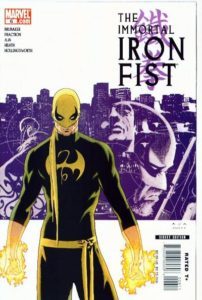 If you want to check out Iron Fist before the upcoming Netflix series, try out the series written by Ed Brubaker and Matt Fraction. It was critically acclaimed when it came out, but for some reason or another (i.e., monetary limitations preventing me from reading everything), I never got around to trying it out.
If you want to check out Iron Fist before the upcoming Netflix series, try out the series written by Ed Brubaker and Matt Fraction. It was critically acclaimed when it came out, but for some reason or another (i.e., monetary limitations preventing me from reading everything), I never got around to trying it out.
Until now, that is. Comixology digitally gave away the first trade paperback for free recently. So of course I read it. And yes, it is quite good.
Issue #6 wraps up the first storyline and leads into the next. This is where the action ramps up, with welcome assists from Luke Cage, Misty Knight, and Colleen Wing (Netflix viewers have already met the first two, and I’m assuming we’ll meet Colleen soon, too). Additionally—and this gets to the meat of the story—a previous Iron Fist fights alongside current Iron Fist Danny Rand (yes, I somehow never got into the most prominent superhero who shares my first name…so psychoanalyze whatever that means).
Superhero comics tend to handle themes of legacy and lineage rather well, and a martial artist superhero is a particularly good fit for such subject matter. After all, martial arts involve the passing of specialized knowledge down through the generations.
This is a more serious take on Iron Fist than when what we see in the current, more lighthearted Power Man and Iron Fist series. But both books are solid—which one you enjoy more may well depend on your mood at the time.
In any case, The Immortal Iron Fist makes me all the more optimistic about the Netflix series.
And fun fact: Apparently, Carrie-Anne Moss’s character in Jessica Jones, Jeri Hogarth, was originally the male Jeryn Hogarth, who ran Danny Rand’s company in the comics. I did not know that.
Writers: Ed Brubaker & Matt Fraction
Artist: David Aja
Publisher: Marvel Comics
How to Read It: back issues; Marvel Unlimited; Comixology; included in The Immortal Iron Fist vol. 1: The Last Iron Fist Story (TPB)
Appropriate For: ages 14 and up
February 3, 2017
Today’s Super Comic — New Mutants #27 (2011)
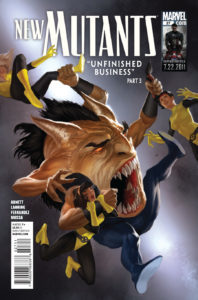 While it can be lots of fun to mix and match various members of the X-Men’s extended cast, there are some established groupings that are always great together. One, naturally, is the X-Men’s original spinoff team, the New Mutants. The ‘80s lineup made a comeback in the last decade, and the cast chemistry remained intact.
While it can be lots of fun to mix and match various members of the X-Men’s extended cast, there are some established groupings that are always great together. One, naturally, is the X-Men’s original spinoff team, the New Mutants. The ‘80s lineup made a comeback in the last decade, and the cast chemistry remained intact.
Of course, they’re not kids anymore, nor are they Xavier’s students. When Dan Abnett and Andy Lanning took over the writing, they laid out a new mission statement for the team: Cyclops has tasked the New Mutants with taking care of the X-Men’s numerous loose ends (Cyclops was basically the X-Men’s general in this era).
Their first order of business is to find X-Man, an alternate-reality version of Cable from the “Age of Apocalypse” timeline who migrated to the main Marvel timeline (you can see why the X-Men might have a few loose ends here and there). To prevent things from being too easy, X-Man is a captive of the amoral Sugar Man, another “Age of Apocalypse” émigré, but one who just wants to find his way back.
In #27, we get to see the grown-up classic team in action, but one founding member in particular gets to shine. Dani Moonstar, depowered mutant and current team leader, has a lengthy one-on-one (and interdimensional) battle with the vicious Sugar Man, proving she’s a formidable fighter even without the aid of super-powers.
Much of the issue’s appeal boils down to “likeable character being awesome.” It’s not deep, but it absolutely works.
Writers: Dan Abnett & Andy Lanning
Artist: Leandro Fernandez
Publisher: Marvel Comics
Cover: Marko Djurdjevic
How to Read It: back issues; Marvel Unlimited; Comixology; included in New Mutants vol. 4: Unfinished Business (TPB)
Appropriate For: ages 12 and up
February 2, 2017
Today’s Super Comics — Wolverine #62-65 (2008)
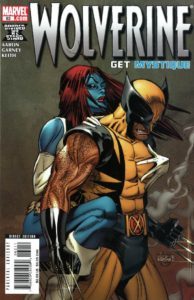 Wolverine pursues Mystique for four issues. It makes for quite the cat-and-mouse game, and it works because of the long history between the characters—a history that gets embellished via flashbacks here.
Wolverine pursues Mystique for four issues. It makes for quite the cat-and-mouse game, and it works because of the long history between the characters—a history that gets embellished via flashbacks here.
Before Wolverine #62, Mystique had recently betrayed the X-Men yet again, and she’s on the run. Cyclops tasks Wolverine with bringing her in, preferably dead (Cyclops had gotten into a dark period—and never really found his way out, come to think of it). Wolverine tracks her across countries while flashbacks show us how he first met Mystique back in 1921 and how they became allies (and a bit more) for a while.
Writer Jason Aaron does a great job adding some depth to Wolverine’s motivation, and he sets up Mystique as an opposite number to Logan. Both are old loners, but whereas Wolverine eventually settled down with his family of X-Men, Mystique has repeatedly rejected that same family.
Another nice touch: Aaron really drills into Wolverine’s head regarding his healing power and how he experiences it. He gives us a clear picture of someone who looks invincible on the outside but is actually in constant physical pain.
These four issues are as violent as you would expect of a Wolverine comic, but there’s a solid story and solid characters beneath it all.
Writer: Jason Aaron
Artist: Ron Garney
Publisher: Marvel Comics
How to Read It: back issues; Marvel Unlimited; Comixology; Wolverine: Get Mystique (TPB)
Appropriate For: ages 15 and up
February 1, 2017
Today’s Super Comics — Avengers Forever #1-12 (1998-1999)
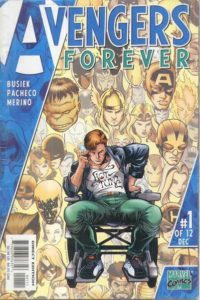 This was a fun idea for a time-traveling team book. In Avengers Forever, it’s not just an Avengers team traveling through time—it’s an Avengers team with representation from different eras, past, present, and future. A multi-temporal lineup.
This was a fun idea for a time-traveling team book. In Avengers Forever, it’s not just an Avengers team traveling through time—it’s an Avengers team with representation from different eras, past, present, and future. A multi-temporal lineup.
And it’s an interesting lineup: Captain America at his most disillusioned, the present-day Wasp to provide leadership, an unhinged and untrustworthy Yellowjacket, a past Hawkeye from right after a classic story, and others.
The plot involves ones of the Avengers’ most prominent enemies, Kang the Conqueror (also a time-traveler, naturally), as well as Rick Jones, professional supporting character. Rick was around when the Avengers first formed, and he’s participated in several key moments in Marvel history, so he’s well utilized in a book that delves into large chunks of Avengers continuity.
The interactions between time-displaced Avengers make the book an entertaining read, but this isn’t a series for anyone new to comics. Given the density of continuity references at times, the book works much better for already-established fans. And I, as an already-established fan, enjoyed it tremendously.
All together, it’s an impressive feat from writers Kurt Busiek and Roger Stern (plotting it out must have been taken, well, forever), and artist Carlos Pacheco is in top form with his reliably dynamic pencilwork.
Writers: Kurt Busiek and Roger Stern
Penciler: Carlos Pacheco
Inker: Jesus Merino
Publisher: Marvel Comics
How to Read It: back issues; Marvel Unlimited; Comixology; Avengers Forever (TPB)
Appropriate For: ages 11 and up
January 31, 2017
Today’s Super Comic — Mockingbird #5 (2016)
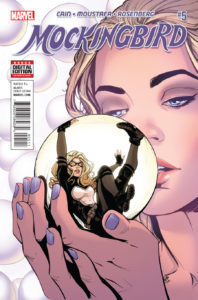 Zombies. A super-powered Mockingbird (sort of). Back-up in the form of the Miles Morales Spider-Man and Howard the Duck.
Zombies. A super-powered Mockingbird (sort of). Back-up in the form of the Miles Morales Spider-Man and Howard the Duck.
Yep, it’s a fun time indeed in Mockingbird #5. You really can’t go wrong with zombies overrunning a SHIELD medical facility. I’m surprised it hasn’t happened before (or maybe it has—I can’t read everything, alas).
Writer Chelsea Cain has developed a distinct voice for this series, keeping both the humor and the stakes high throughout. She also brings an unconventional plotting style. Each of the first five issues can stand on its own as a self-contained story (well, maybe less so with #1 and #5), and they can ostensibly be reread in any order while still building the same larger narrative. I haven’t tried the latter, but the idea is certainly intriguing. Nothing wrong with a good structural experiment, especially since it’s all entertaining regardless.
I’m up for more.
Writer: Chelsea Cain
Penciler: Ibrahim Moustafa
Cover: Joelle Jones and Rachelle Rosenberg
Publisher: Marvel Comics
How to Read It: recent back issues; Marvel Unlimited; Comixology; included in Mockingbird vol. 1: I Can Explain (TPB)
Appropriate For: ages 13 and up
January 30, 2017
Today’s Super Comic — X-Men #98 (1976)
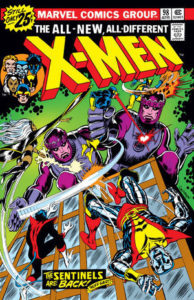 Allow me to pinpoint the issue where Chris Claremont’s legendary X-Men run started getting great:
Allow me to pinpoint the issue where Chris Claremont’s legendary X-Men run started getting great:
X-Men #98. The preceding issues show lots of promise, but here’s where the momentum and excitement begin to kick in.
It opens as many great X-Men stories do—with the team enjoying some downtime, just trying to live their lives, until the world’s fear and hatred get in their way. In this case, that fear and hatred manifest in the form of the robotic, mutant-hunting Sentinels.
(Coincidentally, one of the strongest ‘60s X-Men stories was the Sentinels’ debut, and here their return coincides with the book’s tremendous increase in quality. Makes sense, then, that the ‘90s cartoon used them in the pilot episode.)
The Sentinels capture Jean Grey, Wolverine, and Banshee, who then must fight their way through bigots and robots. They’ve been abducted to a facility at an unknown location, and when they learn exactly where they are…yeah, that’s going to pose some new challenges.
Part of the X-Men’s success has involved mixing and matching great characters and watching them play off each other. This issue gives an early example of that by pulling together three X-Men who had hardly ever functioned as a team, and certainly not with just the three of them.
It’s especially interesting to read this early-draft version of Wolverine. He’s acquired quite the convoluted backstory over the years, but none of that’s known at this point. He’s basically an irritable mystery man, and the script hints that there’s more to his past than we may suspect. It’s even suggested he might not be a mutant, and Cyclops questions whether he’ll work out as an X-Man. Both of those proved to be absolutely wrong, but one thing that did take hold—we get some of the earliest signs of Wolverine’s burgeoning crush on Jean.
The X-Men are definitely in their formative years here. The best is yet to come, but this issue offers up a great start.
Writer: Chris Claremont
Penciler: Dave Cockrum
Inker: Sam Grainger
Publisher: Marvel Comics
How to Read It: back issues; Marvel Unlimited; Comixology; included in Essential X-Men vol. 1 (TPB)
Appropriate For: ages 9 and up
January 29, 2017
Today’s Super Comics — Green Arrow #1-5 (2016)
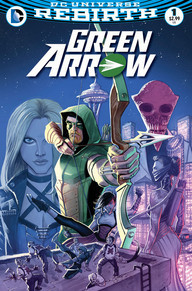 The DC Universe Rebirth trade paperbacks are starting to come out, so I’m finally digging into some. I’ve heard good things about the new Green Arrow, so that seemed like a good place to start. And it was.
The DC Universe Rebirth trade paperbacks are starting to come out, so I’m finally digging into some. I’ve heard good things about the new Green Arrow, so that seemed like a good place to start. And it was.
The first storyline breaks Oliver Queen down by ridding him of the wealth that had defined him, and it builds him back up by replacing that wealth with meaningful relationships.
A particularly welcome addition to the cast is Black Canary. The Green Arrow/Black Canary team has a lot of history, which unfortunately was erased during the New 52 reboot. They’re starting fresh here, and while that removes the weight of history from their interactions, their chemistry remains intact. The pairing seems just as natural as before.
Viewers of the Arrow television series would expect Oliver to have a younger sister, and he does, but it’s not Thea Queen. She’s Emiko, daughter of Robert Queen and Shado. Shado’s in a purely antagonistic role here, testing Emiko’s loyalties. The character definitely has some potential.
John Diggle, a TV show creation (if I recall correctly), has been fully integrated into the comics. (No Felicity, though.)
It’s a solid supporting cast that fills various voids in Green Arrow’s life…but the book makes sure he doesn’t get too comfortable, of course.
I still prefer the old continuity, but for at least this series, the current status quo is acceptable—thanks to the quality of these first five issues.
Writer: Benjamin Percy
Artists: Otto Schmidt and Juan Ferreyra
Publisher: DC Comics
How to Read It: recent back issues; Comixology; included in Green Arrow vol. 1: The Death & Life of Oliver Queen (TPB)
Appropriate For: ages 13 and up
January 28, 2017
Today’s Super Comic — Spider-Man #6 (2016)
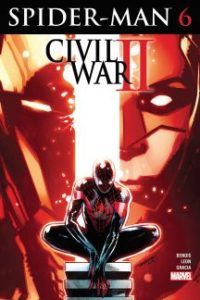 Even with a Civil War II tie-in, Spider-Man remains strong. It always helps to have a Jessica Jones guest appearance.
Even with a Civil War II tie-in, Spider-Man remains strong. It always helps to have a Jessica Jones guest appearance.
However, Jessica is ultimately a small part of issue #6. Iron Man swoops in and steals a chunk of page-time with his current moral conundrum. I’ve read only the first three issues of Civil War II on Marvel Unlimited, so I’m reserving overall judgment, but it’s at least stronger than the original (many like the original story, but I’m not a fan; the movie’s great, though). Basically, there’s an Inhuman who can see the future. Captain Marvel wants to use the young man’s powers to preemptively avert disaster, but Iron Man foresees a slippery slope in going after criminals before they strike. It’s a solid sci-fi premise.
So Iron Man poses his conundrum to young Miles, and Miles, in turn, poses it to his father. The latter interaction is what helps this tie-in be successful, as it facilitates a nice father-son moment. Miles’s family life grounds the series in a relatable, human foundation…even when his grandmother does things like hiring a private investigator to find out if he’s on drugs.
Writer: Brian Michael Bendis
Artist: Nico Leon
Publisher: Marvel Comics
How to Read It: recent back issues; Marvel Unlimited; Comixology
Appropriate For: ages 10 and up
January 27, 2017
Today’s Super Comic — Captain America #27 (2007)
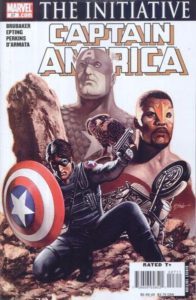 The title character may be dead, but Captain America #27 features lots of great escalation.
The title character may be dead, but Captain America #27 features lots of great escalation.
Everyone is still mourning Captain America in their own way. Tony Stark is taking it rather hard, on account of the guilt he feels regarding the “Civil War” debacle. Sharon Carter has quit SHIELD. Bucky Barnes decides to gather Cap’s equipment. The Falcon tries to find Bucky. And so on.
The Black Widow enters the story, and we learn there’s a bit of backstory between her and Bucky. Makes sense, as both were used and manipulated by the Russian government.
The issue begins with Stark’s public proclamation that no one else will take over as Captain America—Steve Rogers was one of a kind and the decision is final. So that’s crying out to be boldly defied.
Bucky has a nice moment at a Captain America memorial, talking to an old woman who says Cap saved her father during a particular battle in World War II. Bucky knows the statement to be factually incorrect, but he chooses not to spoil her father’s memory. It’s a nice little touch that makes him a bit more likable. And that’s kind of important, given the role he’ll be playing as the story unfolds.
Captain America’s death may look like a big event comic, but it’s actually a terrific character-driven story.
Writer: Ed Brubaker
Penciler: Steve Epting
Inker: Mike Perkins
Publisher: Marvel Comics
How to Read It: back issues; Marvel Unlimited; Comixology; included in Captain America: The Death of Captain America vol. 1 (TPB)
Appropriate For: ages 14 and up
January 26, 2017
Today’s Super Comic — Legion of Super-Heroes #1 (2005)
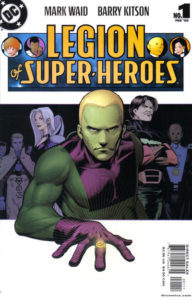 The Legion of Super-Heroes is one of those franchises I sampled a few times but just couldn’t get into. It probably had to do with the incredibly large cast—there were so many colorful characters, but no real focal point to latch onto (in the random issues I read, anyway). I could never find my way in. Until the 2005 reboot, that is.
The Legion of Super-Heroes is one of those franchises I sampled a few times but just couldn’t get into. It probably had to do with the incredibly large cast—there were so many colorful characters, but no real focal point to latch onto (in the random issues I read, anyway). I could never find my way in. Until the 2005 reboot, that is.
The top-notch talent of writer Mark Waid and artist Barry Kitson gave us a 31st century for the 21st. In this version of the future, Earth is a utopia…and the youth are bored out of their minds. The rebellious young Legionnaires crave independence and seek to recapture the spirit of the heroic age from the distant past (our present). In the case of issue #1, that means everything from stopping a malfunctioning giant robot to aiding rebel forces on a war-torn alien planet.
The Legion isn’t just a superhero team; it’s a community and a way of life for these young people. And that community angle allows the book to turn its abundant cast into a strength.
The series takes its time introducing the cast and allows different characters to come into focus in different issues. The first issue has a bit more work to do, and we see several Legionnaires in action, but two characters in particular provide focal points.
The Invisible Kid is the new recruit who allows us to see the Legion through fresh eyes—a standard but effective issue-one strategy. More interesting is the leader, Cosmic Boy, who’s trying to play nice with the United Planets council, in defiance of his own individualistic streak. It’s a superb inner conflict that sets the tone for the series.
So yes, that one time I got into the Legion of Super-Heroes…it started right here.
Writer: Mark Waid
Penciler: Barry Kitson
Publisher: DC Comics
How to Read It: back issues; included in Legion of Super-Heroes vol. 1: Teenage Revolution (TPB)
Appropriate For: ages 11 and up



